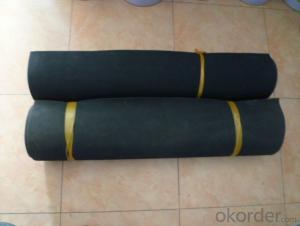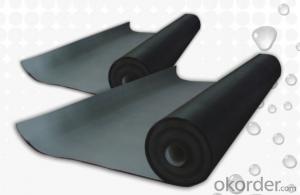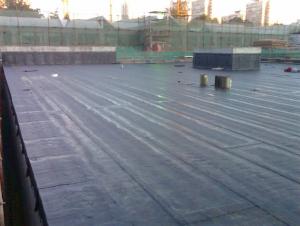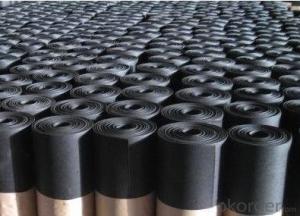EPDM Coiled Rubber Waterproof Membrane for Basement
- Loading Port:
- Shanghai
- Payment Terms:
- TT or LC
- Min Order Qty:
- 10000 m²
- Supply Capability:
- 1200000 m²/month
OKorder Service Pledge
OKorder Financial Service
You Might Also Like
EPDM Coiled Rubber Waterproof Membrane for Basement
Description Of EPDM Coiled Rubber Waterproof Membrane for Basement:
1. EPDM waterproof membrane is made from ternary ethylene-propylene rubber, which is for waterproofing of exposed and non-exposed applications.
2. EPDM waterproof membrane production adopts the world-advanced equipment of cold feeding extrusion and continuous vulcanization technology.
3. EPDM waterproof membrane is of high elasticity among high polymer waterproof materials and becomes a world-popular waterproofing material.
Main Features of EPDM Coiled Rubber Waterproof Membrane for Basement:
1. Excellent physical and mechanical performance
2. High tearing resistance
3. Good deformation adaptability
4. High puncture resistance
5. High aging resistance
6. UV resistance
Specifications of EPDM Coiled Rubber Waterproof Membrane for Basement:
| Material | EPDM Rubber |
| Size | 1.2m (width)*20m (length) or customized, weldable type 2.05m or 4m width |
| Thick | 1.2mm, 1.5mm, 2.0mm |
| Type | Vulcanized & Weldable |
| Pattern | Non-reinforced (homogeneous) |
| Certificate | ISO9001/14001 |
Applications of EPDM Coiled Rubber Waterproof Membrane for Basement:
1.Roofs, Basement, Toilets
2. Industrial and civil building waterproofing
3. Geosynthetic liner for swimming pool, channels, irrigation system
4. Especially suitable for projects with high requirements in durability, anti-corrosion and deformation.

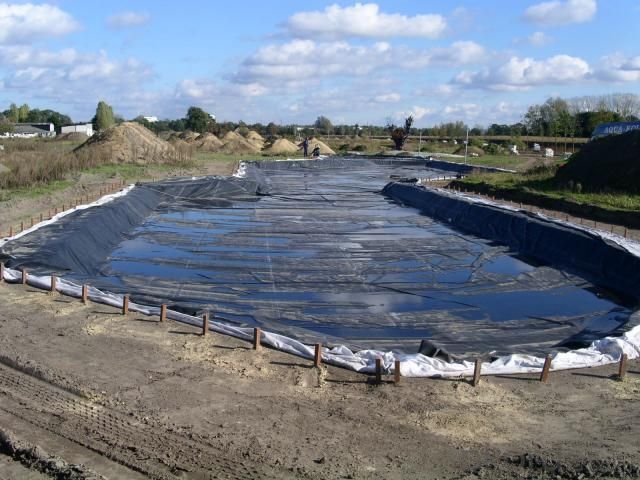

IMages of EPDM Coiled Rubber Waterproof Membrane for Basement:
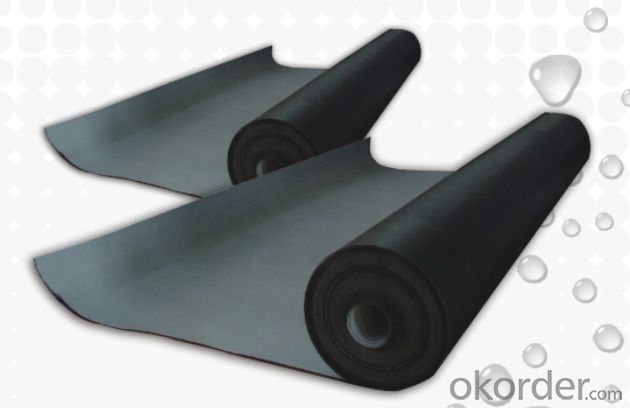



FAQ EPDM Coiled Rubber Waterproof Membrane for Basement:
1. What are we supplying?
We are specialized in producing Colorful Asphalt Roof Shingle, SBS/APP modified bitumen waterproof membrane, Self adhesive bitumen waterproof membrane, PVC waterproofing membrane, EPDM rubber roofing membrane, Single Component Polyurethane Waterproof Coating, and Spray Polyurea Waterproof Coating
.
2. How Many years experience do we have?
We have been exported to more than 20 countries in the past 15 years.
3. How long do we usually reply your request?
We always reply our customer within 24 hours.
- Q:Are there any specific considerations for installing a waterproofing membrane on masonry surfaces?
- When installing a waterproofing membrane on masonry surfaces, there are several important factors to keep in mind. First and foremost, it is crucial to thoroughly clean and prepare the masonry surface before installing the membrane. This means removing any loose debris, dirt, or old coatings that could hinder the membrane's ability to adhere. Choosing the right type of waterproofing membrane is also essential. Since masonry surfaces can vary in terms of porosity and texture, it is important to select a membrane that is compatible with the specific type of masonry. This will ensure optimal results and maximum effectiveness. In addition, proper surface preparation and priming are necessary before applying the membrane. This may involve using a primer that improves adhesion and creates a strong bond between the masonry and the membrane. The installation technique is another crucial aspect to consider. It is important to apply the membrane evenly and smoothly, avoiding any gaps, wrinkles, or air bubbles that could compromise its performance. Following the manufacturer's guidelines and recommendations regarding the application method and curing time is also vital. Lastly, regular inspection and maintenance are necessary to ensure the long-term effectiveness of the waterproofing membrane. This includes periodically checking for any signs of damage, such as cracks or peeling, and promptly addressing any issues that arise. By taking these specific factors into account, a waterproofing membrane can be successfully installed on masonry surfaces, providing reliable protection against water infiltration and damage.
- Q:Are waterproofing membranes resistant to punctures?
- Yes, waterproofing membranes are designed to be resistant to punctures. They are typically made from durable materials that can withstand external forces without tearing or puncturing, ensuring long-lasting protection against water intrusion.
- Q:Can a waterproofing membrane be used in conjunction with a drainage system?
- Using a waterproofing membrane alongside a drainage system is indeed a viable option. In fact, it is frequently advised to employ both simultaneously to achieve optimal waterproofing and drainage results in spaces like basements, roofs, and foundations. The waterproofing membrane serves as a shield against water infiltration, while the drainage system effectively eliminates any surplus water build-up. Through the integration of these two systems, a comprehensive solution is guaranteed to safeguard the structure against potential water-related harm.
- Q:Can a waterproofing membrane be used in commercial buildings?
- Yes, a waterproofing membrane can be used in commercial buildings. Waterproofing membranes are used to protect various parts of a building, including roofs, foundations, and basements, from water intrusion. In commercial buildings, where there may be a higher risk of water damage due to larger surface areas, increased foot traffic, and complex architectural designs, waterproofing membranes can provide an effective solution. These membranes are designed to create a protective barrier against water, preventing leaks, dampness, and potential structural damage. Additionally, waterproofing membranes can enhance the longevity of the building by reducing the risk of deterioration caused by water exposure. Thus, incorporating a waterproofing membrane system in commercial buildings can help maintain a safe and dry environment, protect valuable assets, and maximize the lifespan of the structure.
- Q:Are there any specific safety precautions to consider when installing a waterproofing membrane?
- Yes, there are several safety precautions to consider when installing a waterproofing membrane. Firstly, it is important to wear proper personal protective equipment (PPE) such as gloves, goggles, and a respirator to protect against potential chemical exposure and inhalation of fumes. Additionally, ensure adequate ventilation in the work area to prevent the buildup of fumes. It is also crucial to follow the manufacturer's instructions and guidelines for installation to minimize the risk of accidents or improper application. Lastly, be cautious of potential hazards such as slippery surfaces, sharp edges, or working at heights, and take necessary precautions to prevent falls or injuries.
- Q:Can a waterproofing membrane be used in laundry rooms?
- Yes, a waterproofing membrane can be used in laundry rooms. Laundry rooms are areas where water and moisture are commonly present due to washing machines, sinks, and other water-related activities. Installing a waterproofing membrane in the laundry room can help prevent water damage to the walls, floors, and other structural components. It acts as a barrier against water penetration, ensuring that any water or moisture that accumulates in the room does not seep into the underlying surfaces. This can be particularly beneficial in laundry rooms located on upper floors or in areas prone to high humidity or flooding. By using a waterproofing membrane, homeowners can protect their laundry rooms from potential water-related issues, such as mold growth, rotting, or structural damage.
- Q:Are waterproofing membranes resistant to chlorine exposure?
- Yes, waterproofing membranes are typically resistant to chlorine exposure.
- Q:Can a waterproofing membrane be used on precast gypsum surfaces?
- Yes, a waterproofing membrane can be used on precast gypsum surfaces. This membrane acts as a barrier to prevent water penetration and can be applied to protect the gypsum surface from moisture damage.
- Q:Are there any specific considerations for installing a waterproofing membrane on metal surfaces?
- Yes, there are specific considerations for installing a waterproofing membrane on metal surfaces. When installing a waterproofing membrane on metal surfaces, it is important to consider the compatibility of the membrane with the specific type of metal being used. Some waterproofing membranes may not adhere well to certain types of metal surfaces, so it is necessary to choose a membrane that is specifically designed for use on metal. Additionally, it is important to ensure that the metal surface is properly prepared before installing the waterproofing membrane. This may involve cleaning the surface thoroughly to remove any dirt, grease, or other contaminants that could interfere with the adhesion of the membrane. It may also be necessary to prime the metal surface to improve adhesion. Another consideration is the expansion and contraction of the metal surface due to temperature changes. Metal surfaces can expand and contract significantly with temperature variations, and this movement can potentially affect the performance of the waterproofing membrane. Therefore, it is important to choose a membrane that can accommodate the movement of the metal without compromising its waterproofing capabilities. Furthermore, it is essential to consider the type of waterproofing membrane being used. There are different types of membranes available, including liquid-applied membranes, sheet membranes, and peel-and-stick membranes. Each type of membrane has its own installation requirements, so it is crucial to follow the manufacturer's guidelines to ensure proper installation on metal surfaces. Lastly, it is important to consider any additional factors that may affect the performance of the waterproofing membrane on metal surfaces. These factors can include exposure to UV radiation, potential for corrosion, and compatibility with other building materials or systems. Taking these considerations into account will help ensure a successful and long-lasting installation of a waterproofing membrane on metal surfaces.
- Q:Can waterproofing membranes be used on mechanical equipment rooms?
- Waterproofing membranes are suitable for application in mechanical equipment rooms. These membranes have been specifically designed to create a protective barrier, safeguarding against water penetration and preventing any potential harm caused by moisture to the underlying structures. The installation of these membranes within mechanical equipment rooms, which often house valuable and sensitive machinery, proves advantageous as it ensures the durability and functionality of the equipment. By applying waterproofing membranes to the walls, floors, and ceilings of these rooms, it effectively prevents water leaks, moisture accumulation, and any potential harm resulting from water infiltration. This is particularly crucial in regions that experience heavy rainfall, high humidity, or possess a high water table. Additionally, the use of waterproofing membranes aids in regulating condensation and discouraging the growth of mold, both of which could adversely impact the performance of mechanical equipment. In summary, the utilization of waterproofing membranes in mechanical equipment rooms offers a practical and efficient solution for equipment protection and the maintenance of optimal performance.
1. Manufacturer Overview |
|
|---|---|
| Location | |
| Year Established | |
| Annual Output Value | |
| Main Markets | |
| Company Certifications | |
2. Manufacturer Certificates |
|
|---|---|
| a) Certification Name | |
| Range | |
| Reference | |
| Validity Period | |
3. Manufacturer Capability |
|
|---|---|
| a)Trade Capacity | |
| Nearest Port | |
| Export Percentage | |
| No.of Employees in Trade Department | |
| Language Spoken: | |
| b)Factory Information | |
| Factory Size: | |
| No. of Production Lines | |
| Contract Manufacturing | |
| Product Price Range | |
Send your message to us
EPDM Coiled Rubber Waterproof Membrane for Basement
- Loading Port:
- Shanghai
- Payment Terms:
- TT or LC
- Min Order Qty:
- 10000 m²
- Supply Capability:
- 1200000 m²/month
OKorder Service Pledge
OKorder Financial Service
Similar products
New products
Hot products
Hot Searches
Related keywords
